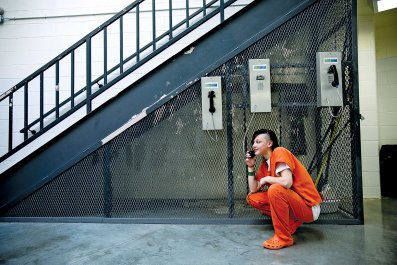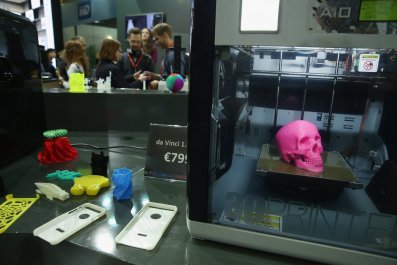Before the opening match of the 2014 World Cup in São Paulo, Juliano Pinto, a young paraplegic Brazilian, was brought out onto the sidelines wearing a huge exoskeleton. Atop his head was a cap that monitored his brain waves and sent the information to a computer, which then translated the signals and fed them down to the mechanical structure strapped to his body. As the crowd of 50,000 looked on, Pinto's foot flicked—and a soccer ball slid down an inclined ramp.
It wasn't exactly a booming Pelé shot to the back of the net, but the kick still resonated around the world, which thrilled Miguel Nicolelis, who oversees the team that worked on the technology. Nicolelis is tired of the usual incremental milestones that mark scientific work. "I don't believe in that," he says. "That's why I did the World Cup thing—I wanted to prove that people could walk again."
Brain-computer interface technology (BCI) is a way to repair severe damage done to the mind-body bridge by injury or disease. It's a medical science still very much in the experimental stages, but patients of brain-stem strokes, spinal cord injuries, Lou Gehrig's disease (amyotrophic lateral sclerosis) and more are now taking part in trials that, neuro-researchers hope, will make them able to communicate and move again one day.
Nicolelis is working with eight paralyzed patients, including Pinto, and most of them have recovered some degree of mobility and tactile sensations. But to accomplish small actions while encased in a huge exoskeleton is hardly enough to make the bionic man or woman of neuroscientists' dreams.
The goal is to return full control of the body to a patient. The problem is that the brain is notoriously hard to read. Every time your brain sends a signal to your body, each individual brain cell emits a whole bunch of pulses—you can hear a "pop, pop, pop" on devices used to measure brain waves. If you are trying to get your hand to move to the right, the brain might fire 10 times. But only one of those actually means "move hand to the right." The rest are just noise that needs to be screened out.
The way to do that, neuroscientists think, is to have an electrode—an electrical conductor—monitor brain activity measured in wavelengths, as exactly as possible. As a beginning, John Donoghue, founder of the neuroscience department at Brown University, who is working with an international team of researchers on a project called BrainGate, developed a chip smaller than a penny and fine as a hair. Containing about 100 electrodes, the chip is implanted in the motor cortex, where its electrodes pick up the electric pulses from nearby neurons and transmit them via cables to a computer, which deciphers them and tells an external object—a computer cursor or a robotic arm—to move. The patient thinks, Move the robot leg; the computer makes it so.
But so far, that's about all the system can do. Paralyzed patients with chip implants are not about to rise from their wheelchairs, nor will those without speech have their communication restored in the next few years. That's because these experimental patients have 100 electrodes implanted, reading about that many neurons—while the brain has dozens of billions of neurons. Donoghue believes that if the team members could figure out a way to record every cell in the brain, they could, theoretically, reconstruct it in its entirety in the computer. Then they could "rewire the brain back to the body so they can move their own bodies again."
The U.S. Defense Advanced Research Projects Agency is working on what is probably the strongest attempt at overcoming the limitations of current BCI technology. In January, the government agency said it would offer funding to researchers who were working on "a neural interface system capable of recording from more than one million neurons." Donoghue says he doesn't believe there's an easy solution—but he also hopes DARPA proves him wrong.

Trying to figure out what neurons are doing isn't new, nor are brain implants. For over a decade, chips have been used, for example, in clinical trials to treat neural misfires caused by illnesses like Parkinson's disease and epilepsy. A year and a half ago, the U.S. Food and Drug Administration approved a device called NeuroPace as a sort of defibrillator for brain cells. When a neuron misfires, the preprogrammed chip sends an electronic pulse to it as a way of short-circuiting the epileptic seizure activity.
But there is another aspect of the NeuroPace chip that may help those designing brain-computer interfaces to help the paralyzed: The device records a patient's brain wave activity, downloads it to a computer and sends it to the person's doctors. Not only does that help a patient's doctor figure out how to fine-tune the chip to help epilepsy patients, says Yale School of Medicine neurosurgeon Dennis Spencer; it also gives the doctor more precise data about what is going on as the brain's network of neurons works—or doesn't.
A similar feedback system is key to making brain-computer interfaces a success, says BrainGate neurologist and Brown University professor Leigh Hochberg. The idea is to generate "an iterative process of getting feedback and changing the software so a person can get an intuitive use of their own hand."
Then there is the possibility of having human brains interact through a computer so that a healthy person's brain waves can supplement those of a paralyzed person and help him or her regain muscle control. It's already been attempted in animals by Nicolelis's team—in one study, they linked monkeys' brains together through implants to test that thesis. His team discovered that, when linked together, two (and three) simians learned how to control a computer cursor faster than one monkey alone.
Nicolelis is probably never going to link up two human brains directly, but the monkey experiment gave him an idea that could help with Hochberg's iteration problem. His lab is about to begin a project where a paralyzed patient's brain wave activity will be measured through a cap and fed into a computer. A rehabilitation specialist working on his or her own computer, linked to the patient's machine, would guide the patient through exercises—moving a cursor on a screen, for example. Nicolelis says he thinks this would help a patient regain physical control faster and better.
In April 2016, a report in the journal Nature described one of the latest successes in BCI: Ian Burkhart, paralyzed from the neck down after a swimming accident, had a sleeve fitted to his forearm that he controls through a chip implanted in his brain. Burkhart, 24, can make motions with his hand with a fair degree of accuracy, according to news reports, like pouring a glass of water or playing the video game Guitar Hero. "The first time I was able to open and close my hands, it really gave me a sense of hope for the future," Burkhart told The Washington Post.
While scientists continue to work on the problem of how neurologically impaired patients can utilize BCI to use their limbs again, they are already envisioning the next use of the technology: restoring brain functions that can be destroyed by degenerative brain diseases like Alzheimer's.
For those who have lost a loved one to Alzheimer's, one of the most shocking moments is when they realize that their mom or dad or significant other, once fully functioning, can no longer remember what to do with a toothbrush, let alone who is the nation's secretary of state. The hope, Hochberg says, is that BCI technology could eventually use computers and integrated chips to harness the power of the millions of human neurons that still work in someone with severe memory loss or other cognitive impairment, so that patients could retain control of not only movement and speech but also their memory and ability to think. With only 100 neurons available to feed into computers today, that's a far-off proposition. But it's a start.




















